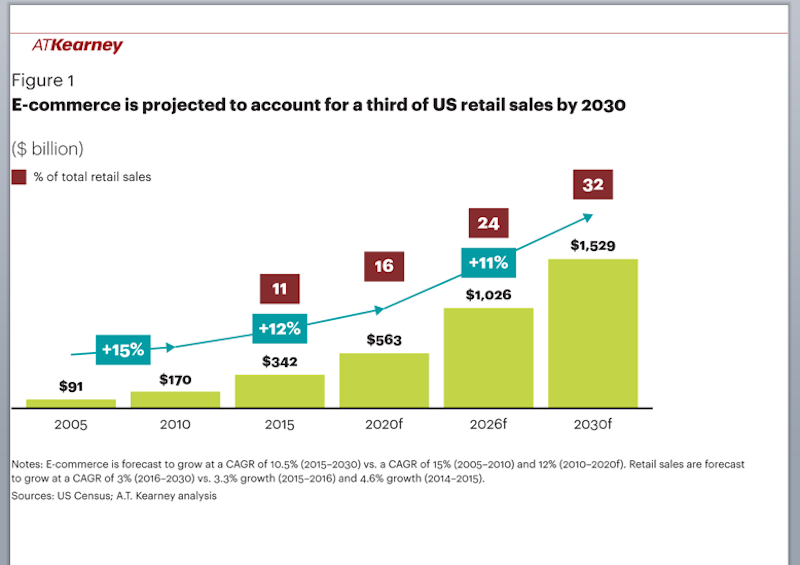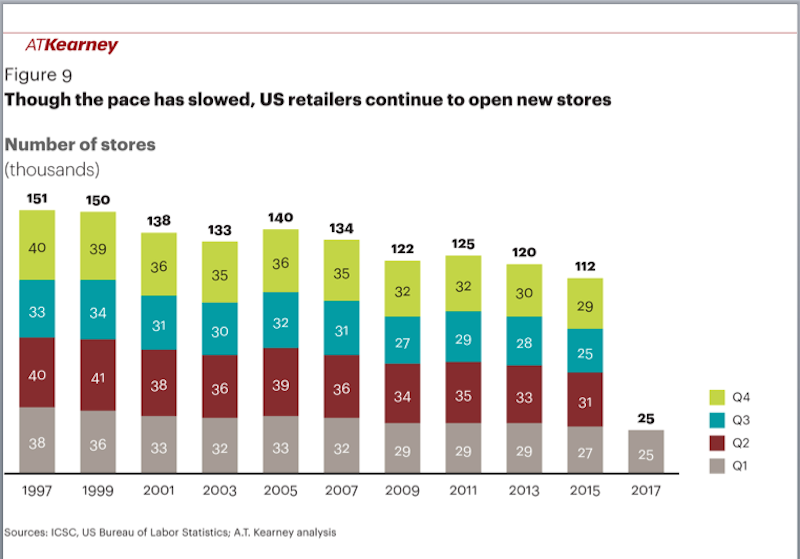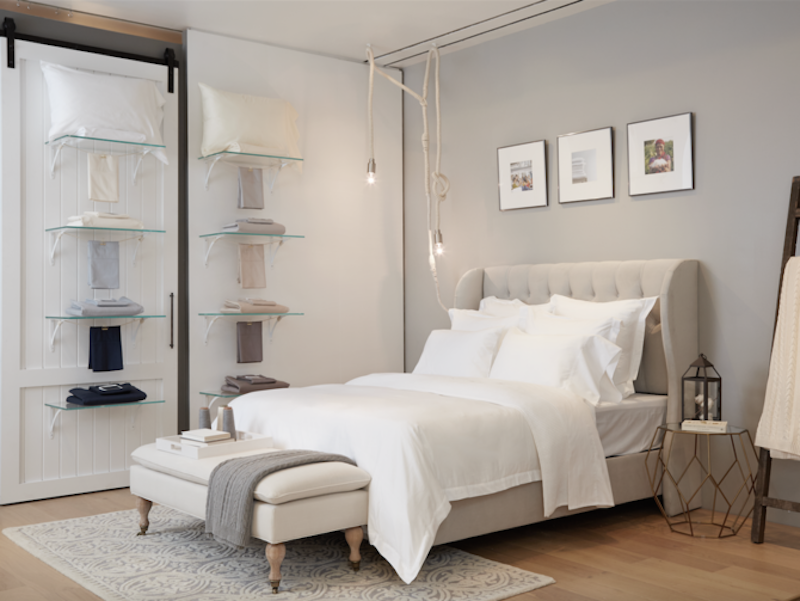Add to the growing list of forecasts about the fate of retailing in America a new report by the global consulting firm A.T. Kearney that suggests the survival of shopping centers and malls will be predicated on their “morphing” into Consumer Engagement Centers (CES) that are less about buying and selling products and more about creating experiences for consumers.
“The U.S. retail sector is moving from a ‘push’ model to a ‘pull’ model where consumers are demanding more curated experiences,” explains Michael Brown, a Partner with A.T. Kearney's retail group, and co-author of “The Future of Shopping Centers.”
The report stems from a larger study his firm conducted to examine and predict prospective consumer behaviors over the next 10-15 years, says Brown. The focus of the latest report is on Millennials, who will reach their peak spending years within the next decade.
The authors note that the U.S., at 23.5 sf of retail space per person, is already seriously overstored, compared to countries like Canada (16.8 sf/person), Australia (11.2 sf), the United Kingdom (4.6 sf), and Japan (4.4 sf). The U.S. also lags Europe when it comes to locating retail in proximity to transportation hubs, and building stores that are part of mixed-use developments.
Looming in the background of A.T. Kearney's forecasts is the expanding encroachment of ecommerce. The report estimates that online purchases could account for 32% of total retail sales in the U.S. by 2030, or the equivalent of $1.53 trillion that year. That would be nearly triple the percentage in 2015, but Brown defends his firm's aggressive projections by noting that ecommerce has barely penetrated the grocery sector yet, but is likely to make a bigger splash there over the next several years, especially in light of Amazon’s $13.4 billion purchase of Whole Foods last year.
In addition, the report expects that, by 2030, at least two-fifths of all consumers will be digital natives who won’t draw distinctions between digital and physical retailing. Consequently, it is critical for retailers to master and embrace digital retailing not only to communicate with shoppers and transact business, but also to identify new customers, track purchases, and analyze patterns.
The report talks about how technology is creating “personalized digital ecologies” for consumers, which CES operators need to tap into along with autonomous, on-demand mobility technologies (from driverless cars to robots) that could play a much bigger role in future shopping experiences.

Online purchases could account for nearly one-third of all U.S. retail sales by 2030. Retailers need to embrace digital commerce to attract consumers who are less disposed to distinguish between on- and offline shopping experiences. Image: A.T. Kearney
Logistics will determine winners from losers
When it comes to product assortments, retailers now find themselves scrambling to respond to consumer fragmentation, which Brown explains is leading toward “micro segmentation” that has the potential to cut into big-brand hegemony. Consequently, retailers need to build a logistical infrastructure driven by data analytics that allows them to offer multiple brands they can switch in and out of relatively quickly as consumer buying trends change.
The report believes consumers are going to want a lot more say in the goods and services that retailers bring to market. Their veto power starts with their smartphones, which give them the alacrity to select, or block, any input they choose. Advances in smartphone technology—along with advances in 3D printing, machine-to-machine interfaces, and artificial intelligence—will not only give consumers greater expectations about the control they wield over what goods and services retailers make available to them, but also how those products are ultimately delivered.
Physical stores aren’t going away; in fact, dealers are opening more stores in the U.S. And the picture about retailing’s future gets muddled when online retailers like Amazon and Boll & Branch are opening brick-and-mortar stores.

Even though the U.S. in overstored, dealers continue to open new outlets, although a growing number are using stores more as showrooms and distribution hubs for pickup by consumers who made their purchases online. Image: A.T. Kearney
But physical space, says Brown, is more likely to be used in the future to display merchandise and build experiences with consumers than to conduct actual buying and selling of products. He points specifically to the sporting goods retailer Foot Locker, which is reducing its store count but enlarging its remaining stores to enhance shoppers’ experience; and the home furnishings retailer Restoration Hardware, which has been opening “mansion” stores, 50,000- to 60,000-sf showrooms that support this dealer’s online selling strategy.
“Walmart and Amazon are successful because of their logistics,” says Brown, “and the speed and agility of a dealer’s infrastructure will be what’s important” going forward.
A.T. Kearney’s report divides successful future shopping centers into four distinct types:
•Destination centers that are regional malls with flagships, tenants that cater to specialized shopper groups, and possibly nontraditional anchors like theme parks. These destination centers could serve as digital distribution hubs, and even offer customers weekend experiences by tying into restaurants, hotels, and local entertainment;
•“Retaildential” centers, mixed-use facilities that are built to incorporate housing and are conveniently located near mass transit options;
•Value centers “that are anchored by an idea, not a retail nameplate,” the report states. Brown explains that value centers might cater to a specific ethnic group of customers, or to comsumers with like interests such as sports, fashion, or dining. These centers could include spaces for concerts, competitions, exhibits, and community events; and
•Innovation centers, that might be part-store, part research facility. They could include test stores and alternating-themed retail environments for the purpose of analyzing shoppers’ needs and behaviors over time.
Related Stories
| Aug 11, 2010
Former nightclub morphing into a shopping center
New York City's Limelight, the one-time notorious church-turned-nightclub, will be restored again, this time as a 25,000-sf retail marketplace. Limelight Marketplace founder Jack Menashe hopes to merge lavish atmospheric elements with cutting-edge fashion, beauty, and gourmet retailers like BookSmart, Caswell Massy, J.
| Aug 11, 2010
And the world's tallest building is…
At more than 2,600 feet high, the Burj Dubai (right) can still lay claim to the title of world's tallest building—although like all other super-tall buildings, its exact height will have to be recalculated now that the Council on Tall Buildings and Urban Habitat (CTBUH) announced a change to its height criteria.
| Aug 11, 2010
New pavilion planned for famous boulevard
Located in a prime spot along Santa Monica Boulevard in the Westwood neighborhood of Los Angeles, the Santa Monica Pavilion will have 9,000 sf of retail space, 35,500 sf of office space, and two below-grade parking levels when it opens in late 2010. The $10 million, three-story building extends a full length of the block to create a window wall of blue-gray translucent, fritted glass panels ove...
| Aug 11, 2010
Mixed-use Seattle high-rise earns LEED Gold
Seattle’s 2201 Westlake development became the city’s first mixed-use and high-rise residential project to earn LEED Gold. Located in Seattle’s South Lake Union neighborhood, the newly completed 450,000-sf complex includes 300,000 sf of Class A office space, 135 luxury condominiums (known as Enso), and 25,000 sf of retail space.
| Aug 11, 2010
Expanding retail complex is LEED pre-certified
The Promenade at Coconut Creek in Broward County, Fla., a live-work-play shopping and lifestyle center, is being expanded by 105,000 sf. When phase II of the 335,000-sf project is complete, the facility will house 75 retailers, restaurants, and related services, making it one of the largest mixed-use projects in northern Broward County.
| Aug 11, 2010
CityCenter projects get LEED Gold
MGM Mirage and Infinity World Development have received LEED Gold certification for the first three CityCenter projects: the ARIA Resort hotel tower, ARIA Resort convention center and theater, and the Vdara Hotel (above). The CityCenter developers anticipate Gold or Silver LEED certification for the project's remaining developments, which include a Mandarin Oriental hotel, a 500,000-sf retail a...
| Aug 11, 2010
RMJM unveils design details for $1B green development in Turkey
RMJM has unveiled the design for the $1 billion Varyap Meridian development it is master planning in Istanbul, Turkey's Atasehir district, a new residential and business district. Set on a highly visible site that features panoramic views stretching from the Bosporus Strait in the west to the Sea of Marmara to the south, the 372,000-square-meter development includes a 60-story tower, 1,500 resi...
| Aug 11, 2010
'Feebate' program to reward green buildings in Portland, Ore.
Officials in Portland, Ore., have proposed a green building incentive program that would be the first of its kind in the U.S. Under the program, new commercial buildings, 20,000 sf or larger, that meet Oregon's state building code would be assessed a fee by the city of up to $3.46/sf. The fee would be waived for buildings that achieve LEED Silver certification from the U.
| Aug 11, 2010
Manhattan's Pier 57 to be transformed into $210 million cultural center
LOT-EK, Beyer Blinder Belle, and West 8 have been selected as the design team for Hudson River Park's $210 million Pier 57 redevelopment, headed by local developer Young Woo & Associates. The 375,000-sf vacant passenger ship terminal will be transformed into a cultural center, small business incubator, and public park, including a rooftop venue for the Tribeca Film Festival.
| Aug 11, 2010
D.C. gets sweeter with expanded green eatery
Greens Restaurant Group has expanded its popular salad and yogurt eatery, sweetgreen, to two neighborhoods in the Washington, D.C., area, Dupont Circle and Bethesda, Md. Designed by local architect CORE architecture + design, the experiential dining projects use salvaged hickory for the walls, wood recycled from the old bowling alleys for the tables and chairs, and sustainable paper/dye product...







